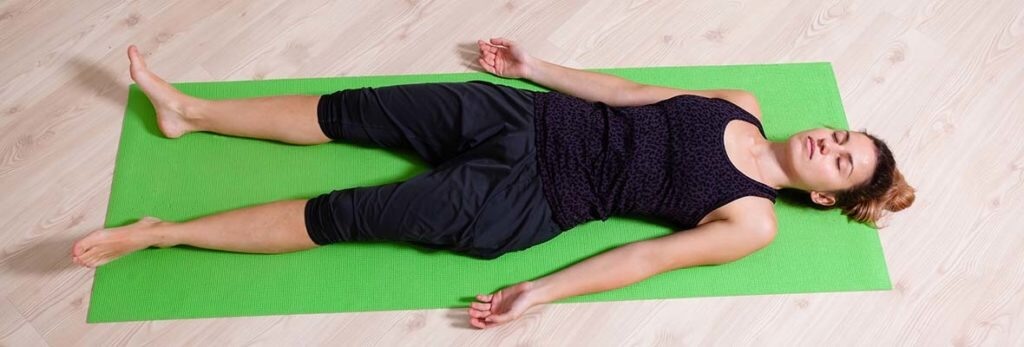Relieve Stress, Increase Relaxation: The Sleep Nidra

“Most people sleep without resolving their tensions. This is termed nidra. Nidra means sleep, no matter what or why, but yoga nidra means sleep after throwing off the burdens. It is of a blissful, higher quality all together.” – Swami Satyananda.
 The modern world is filled with stressors. Day in and day out each of us deal with problems that build up until we’re running in a low-grade state of emergency all the time. Not only does long-term exposure to stress lead to chronic health problems, but stress has a way of directly manifesting in acute illness. What we really need is a way to relax our minds so our bodies can heal. Collectively we need to recognize that much of the dis-ease we experience has a distinct stress component. It’s incumbent upon us as empowered adults to make time for healing our minds. When we take proactive steps to increase the amount of intentional relaxation in our lives, we can get our ship back on the right course. We can win the modern day battle against the negative effects of stress.
The modern world is filled with stressors. Day in and day out each of us deal with problems that build up until we’re running in a low-grade state of emergency all the time. Not only does long-term exposure to stress lead to chronic health problems, but stress has a way of directly manifesting in acute illness. What we really need is a way to relax our minds so our bodies can heal. Collectively we need to recognize that much of the dis-ease we experience has a distinct stress component. It’s incumbent upon us as empowered adults to make time for healing our minds. When we take proactive steps to increase the amount of intentional relaxation in our lives, we can get our ship back on the right course. We can win the modern day battle against the negative effects of stress.
Relax and Renew
To truly enhance the quality of relaxation in our lives, it’ necessary to make a fundamental shift in many of our habitual belief patterns. We need to come to terms with the fact that negative thoughts and beliefs make us physically ill, and eventually, day after day, they have the cumulative effect of separating us from the most important things in life. We become disconnected from our true selves, our families, our communities, and worse: we lose our organic connection to the universe as a whole.
There’s a remedy for all this. We can reconnect. When we embrace our breath, the moment, and a mindful approach to living, we foster a deep and intuitive relationship with everything stress takes us away from. We become more in tune with our bodies. Our parasympathetic nervous system, responsible for releasing (or not) our stress hormones, becomes our friend rather than our enemy. We reconnect to our family, our community, and our culture. We also begin to nurture inner gratitude and acceptance for the gift of life and the beauty of the universe we live in.
The Yoga Nidra
The phrase yoga nidra comes from two ancient Sanskrit words: yoga, meaning union, and nidra, meaning sleep. Together they refer to the practice of a conscious, mindful approach to sleep. When we use it in our modern lives, yoga nidra can be an incredible tool for deepening our emotional, psychological, and physical relaxation. The practice remaps our subconscious and unconscious levels of being. A simple yoga nidra practice can counteract the disconnection and separation we’ve gotten so good at, and shift our inner patterns from those that are negative and destructive to those that are empowering, healing, enlightening, and directed toward a healthy and positive way of moving through the world.
Origin and Application
You don’t have to have previous meditation and or yoga experience to begin a personal practice of yoga nidra. Yoga nidra is an ancient technique that’s finally receiving the attention it deserves in the contemporary therapeutic world. Originally considered an aspect of tantric yoga, it’s deceptively simple at its core: it comes from the traditional yoga concept of nyasa, meaning “to place.” Nyasa means placing your awareness in different parts of the body: to wake up your body, you direct your consciousness to the parts of your body that need it the most.
The deepest aspect of this practice—the rotation of consciousness through the body—happens when the entire human experience is intentionally involved. When you engage all of your senses, a true spiritual transformation takes place.
When you practice yoga nidra, all the human modes of communication—touch, proprioception, sight, hearing, speech and kinesthetic sense of movement—are actively employed. This united activation of the entire mind reduces and eradicates habitual negative thought patterns. In as little as 10 minutes, in the comfort of your own home, office or studio, you can achieve a successful yogic nap of subconscious uncluttering. This quote from Richard Miller crystallizes the positive outcomes of a yoga nidra practice:
“In yoga nidra, we restore our body, senses and mind to their natural function and awaken a seventh sense that allows us to feel no separation, that only sees wholeness, tranquility and well-being.”
Additional Benefits
Along with spiritual awakening, enhanced relaxation, reconnecting with your community and the world as a whole, yoga nidra can also improve your memory, creativity, and your ability to learn—even as an adult. Yoga nidra is used treat insomnia, psychological disorders, and a wide range of psychosomatic diseases. It can relieve muscular, emotional, and psychological tension, as well as restore balance to the endocrine system. That’s all in addition to more finely tuned senses, increased energy, and a deepened physical awareness you quickly feel once you start incorporating yoga nidra into your daily routine.
Getting Started
So how can you begin your journey to cultivating healing through a yoga nidra practice? You can join us here at Skyterra, of course! In the meantime, there are quite a few mindfulness apps for your smartphone, iPad, or tablet that can help you. These guided yoga nidras last from as little as ten minutes to a maximum of the sky is the limit! I hope you love these apps and embrace them like I do. I use them all the time. Here are my three favorites:
- iRelax Meditation – Yoga Nidra
- Deep Relaxation – Yoga Nidra
- Being Still- Yoga Nidra
In closing, I wish you a mindful and stress-free journey to improved mental health and overall wellbeing.
Hari Om Tat Sat
(The Divine Sound: That is the Truth)